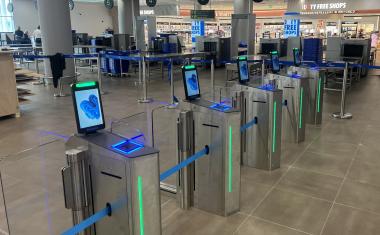Smiths Detection: improved security and more efficient processes at airport checkpoints
Smiths Detection: improved security and more efficient processes at airport checkpoints. As it is unlikely that we will see a reduction in the threat level posed to air travel in t...

Smiths Detection: improved security and more efficient processes at airport checkpoints. As it is unlikely that we will see a reduction in the threat level posed to air travel in the foreseeable future, Smiths Detection has looked to other avenues – to technology advancements – to assist in smoothing our passage through the security channel.
Screening Procedures
The checkpoint security procedure has two main targets: the screening of passengers and of their carry-on bags. For both of these areas, new technologies promise to address the extra requirements that recent events have imposed. Screening activity is standardised by regulation and generally results in a uniform configuration of Xray and metal detector equipment, together with their associated procedures.
aTiX Deployment Worldwide
With the recent development by Smiths Detection of the HI-Scan 6040aTiX system, which is now being deployed, a quiet revolution is occurring in the area of carry-on baggage screening. Technologies that have previously been the preserve of sophisticated hold baggage screening methods are now finding their way into the passenger checkpoint.
The multi-view X-ray aTiX system offers the screener several perspectives of a scanned bag and thus assists greatly in the resolution of suspicious objects in a carry-on item. Moreover, adding threat detection capabilities to this multi-view approach leads to the real breakthrough of providing automated detection of explosives – both liquid and solid – as well as other substances of interest.
By providing the system operator with alarm prompts in the displayed image, the detection performance and time taken in clearing bags are greatly enhanced. The ability of this Smiths Detection technology to distinguish between benign and dangerous liquids holds out the promise of a return to the days before the term 3:1:1 entered the airport lexicon.
Additional inspection angles and the tomography capability of the multi-view aTiX system already permit passengers at UK airports, including London Heathrow and Glasgow, to leave laptops in the bag on a trial basis.
Passenger Flow = Passenger Convenience
Throughput performance depends on various aspects such as equipment balance, alarm resolution and tray return. Here, technical enhancements that assist the procedures can greatly boost the efficiency of the overall checkpoint operation. Observations of the flow process through the security channel have identified where enhancements to the checkpoint infrastructure can make significant differences to the throughput and operational costs.
Bottlenecks such as divestment of personal items onto the X-ray conveyor offer an example of how small changes can make a big difference. Lengthening the loading conveyor so that several people can simultaneously off-load their personal items turns a sequential – one at a time – process into a parallel operation where a slow passenger does not delay the whole line.
Motorised ramps now are used to transport empty trays from the end of the channel back to the start, saving on operator time while also ensuring continuous supply of trays to passengers entering the security lane. Reconfiguring the balance between people and baggage screening processes reduces labour and equipment costs and at the same time harmonises the movement of people and their bags, as they move through the checkpoint.
Smiths Detection has encapsulated these operational improvements to the checkpoint flow into an integrated handling system concept – iLane. iLane facilitates the passenger to pass quickly through the channel. Its first major application is at London Heathrow’s new Terminal 5.
Increased Security plus Improved Passenger
Using an integrated automation approach, the iLane concept incorporates a sophisticated tray handling system, with sensors identifying empty trays which automatically return to the beginning of the checkpoint for passengers entering the lane. Extended entry conveyors allow several passengers to load bags and personal items at any one time.
Bags that are deemed suspicious by the X-ray screener are automatically diverted by the conveyor system into the secondary search area for follow-up inspection. Cleared bags carry straight through for reclaim by the passenger. By incorporating these procedural approaches into a single handling system, the overall efficiency of the checkpoint has been dramatically improved.
Contact:
Charlotte Breitwieser
Smiths Detection,
Wiesbaden, Germany
Tel.: +49 611 9412 189
Fax: +49 611 9412 661
charlotte.breitwieser@smiths-heimann.com
www.smithsdetection.com













